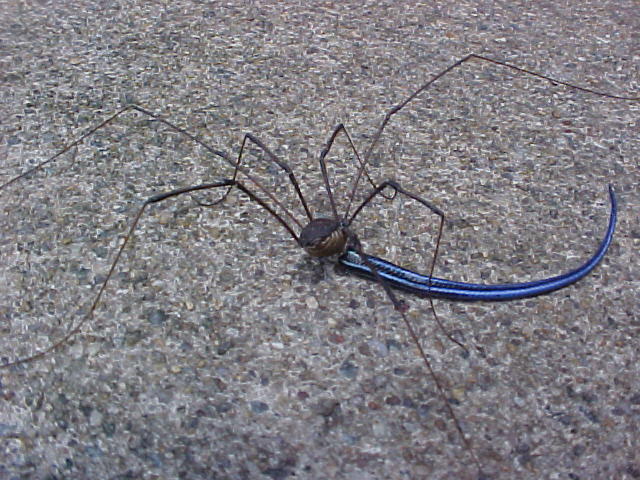|
Poecilaemula Iching
''Poecilaemula iching'' is a species of harvestmen from Central America in the family Cosmetidae. It was first described in 2024 by Medrano, Kury, Martins, and Proud. Distribution It is only known from the vicinity of Bocas del Toro Bocas del Toro (; meaning "Mouths of the Bull") is a province of Panama. Its area is 4,643.9 square kilometers, comprising the mainland and nine main islands. The province consists of the Bocas del Toro Archipelago, Bahía Almirante (Almirante B ..., Panama. References Further reading * (eds.) (2007). ''Harvestmen – The Biology of Opiliones''. Harvard University Press, USA. External links * Harvestmen Cosmetidae {{Opiliones-stub ... [...More Info...] [...Related Items...] OR: [Wikipedia] [Google] [Baidu] |
Harvestmen
The Opiliones (formerly Phalangida) are an Order (biology), order of arachnids, Common name, colloquially known as harvestmen, harvesters, harvest spiders, or daddy longlegs (see below). , over 6,650 species of harvestmen have been discovered worldwide, although the total number of extant taxon, extant species may exceed 10,000. The order Opiliones includes five suborders: Cyphophthalmi, Eupnoi, Dyspnoi, Laniatores, and Tetrophthalmi, which were named in 2014. Representatives of each extant suborder can be found on all continents except Antarctica. Well-preserved fossils have been found in the 400-million-year-old Rhynie cherts of Scotland, and 305-million-year-old rocks in France. These fossils look surprisingly modern, indicating that their basic body shape developed very early on, and, at least in some taxa, has changed little since that time. Their Phylogenetics, phylogenetic position within the Arachnida is disputed; their closest relatives may be camel spiders (Solifugae ... [...More Info...] [...Related Items...] OR: [Wikipedia] [Google] [Baidu] |
Cosmetidae
Cosmetidae is a family of harvestmen in the suborder Laniatores. With over 700 species, it is one of the largest families in Opiliones. They are endemic of the New World with a Nearctic-Neotropical distribution where a large fraction of the diversity of Opiliones are represented by this single family. Cosmetidae have the northern extent of their range into the USA, where a small number species occur in the southern states. However, the family is especially diverse in Mexico, Central America and northern South America; especially the Andean realms. Their range also extends further south into Argentina and southern Brazil, but they are absent in Chile. Cosmetidae are prevalent in Amazonian region, but only relatively few also occur in Brazilian Atlantic Forest. Several species are also found in the Caribbean. Description This family comprises members that may have elaborate white or yellow (but rarely also green/orange/red) markings such as stripes and spots on the dorsal body an ... [...More Info...] [...Related Items...] OR: [Wikipedia] [Google] [Baidu] |
Bocas Del Toro Province
Bocas del Toro (; meaning "Mouths of the Bull") is a Provinces of Panama, province of Panama. Its area is 4,643.9 square kilometers, comprising the mainland and nine main islands. The province consists of the Bocas del Toro Archipelago, Bahía Almirante (Almirante Bay), Chiriquí Lagoon, and adjacent mainland. The capital is the city of Bocas Town, Bocas del Toro, Bocas del Toro (or Bocas Town) on Isla Colón (Colón Island). Other major cities or towns include Almirante, Bocas del Toro, Almirante and Changuinola. The province has a population of 159,228 as of 2023. Christopher Columbus and his crew Fourth voyage of Columbus, first visited the area in 1502. Bocas del Toro borders the Caribbean Sea to the north, Limón Province of Costa Rica and the Naso Tjër Di Comarca to the west, Chiriquí Province to the south, and Ngöbe-Buglé Comarca to the east. The Río Sixaola forms part of the Costa Rica–Panama border, border with Costa Rica. A newly constructed bridge spans the river ... [...More Info...] [...Related Items...] OR: [Wikipedia] [Google] [Baidu] |
Harvestmen
The Opiliones (formerly Phalangida) are an Order (biology), order of arachnids, Common name, colloquially known as harvestmen, harvesters, harvest spiders, or daddy longlegs (see below). , over 6,650 species of harvestmen have been discovered worldwide, although the total number of extant taxon, extant species may exceed 10,000. The order Opiliones includes five suborders: Cyphophthalmi, Eupnoi, Dyspnoi, Laniatores, and Tetrophthalmi, which were named in 2014. Representatives of each extant suborder can be found on all continents except Antarctica. Well-preserved fossils have been found in the 400-million-year-old Rhynie cherts of Scotland, and 305-million-year-old rocks in France. These fossils look surprisingly modern, indicating that their basic body shape developed very early on, and, at least in some taxa, has changed little since that time. Their Phylogenetics, phylogenetic position within the Arachnida is disputed; their closest relatives may be camel spiders (Solifugae ... [...More Info...] [...Related Items...] OR: [Wikipedia] [Google] [Baidu] |


